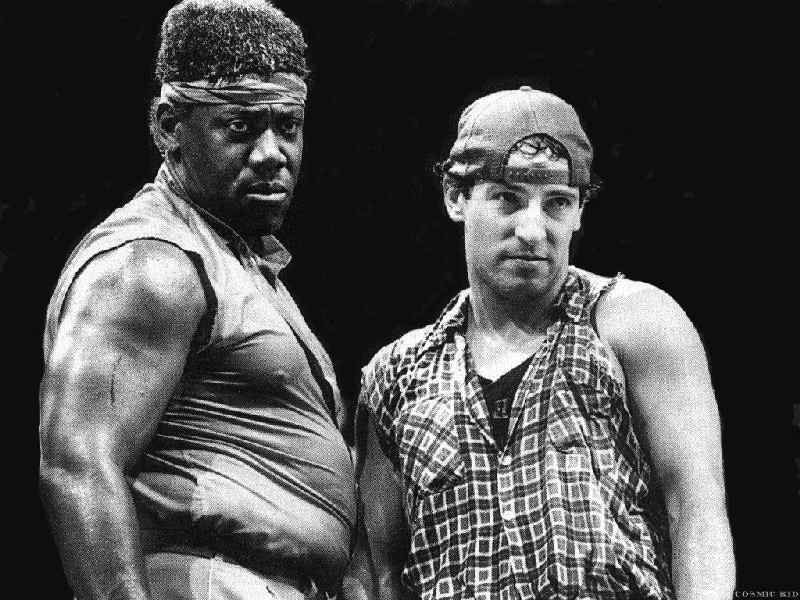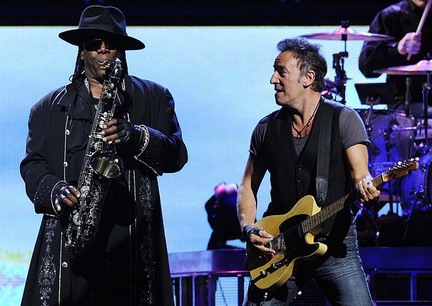Clarence Clemons died on Saturday, of complications from a stroke.
It’s impossible to overstate how important Clemons was to Springsteen’s early mystique – and Bruce knew it; on a stage full of scrawny white guys (and, during David Sanscious’ two years on keyboards, one scrawny black guy), Clemons was a 250 pound former lineman; he’d played at Maryland State, and gotten signed by the Cleveland Browns before an injury from a car accident sidelined him.

Clemons' annual photo at U of Maryland
He spent a few years working as a social worker, moonlighting as a musician until his fabled meeting with Springsteen, almost forty years ago.
Springsteen’s early sound, heavily R ‘n B-based, leaned heavily on the sax; from the slinky uptown meandering of “Spirit In The Night” to Van Morrison-y raveup in “Blinded By The Light”, Clemons’ sound defined the first two albums, Greetings From Asbury Park and The Wild, The Innocent and the E Street Shuffle. As the band grew on Born to Run, Roy Bittan’s piano joined Clemons as the keystone of the band’s sound; Clemons became less a background instrument and more a soloist. His solo from Jungleland – a long, jazzy intermezzo between the thundering bridge (driven by Danny Federici’s Hammond B-3) and the exhausted-sounding “dawn” scene, taped here in 2009 – was one of his greatest:
Clemons was not a virtuoso musician, in the sense that Nils Lofgren or Roy Bittan were; he was compared to King Curtis, and with good reason, but mostly as an inspired imitator, rarely more inspired than on “She’s The One” (here from one of the greatest treasures of Springsteeniana on the web, the gloriously complete video record of the band’s two-night stand at the Capitol Theater in Passaic, New Jersey on the Darkness on the Edge of Town tour):
But he was a performer above all; for forty years, he was Springsteen’s foil, the Abbott to Bruce’s Costello.

Scooter and the Big Man, 1985
Few people explain Clemons better than David Remnick at the New Yorker, whose obit is here. Money quote:
Clemons, who died Saturday of complications from a stroke, was not an entirely original player—he was a vessel of many great soul, gospel, and R&B players who came before him—but he was an entirely sublime band member, an absolutely essential, and soulful, ingredient in both the sound of Springsteen and the spirit of the group. Clemons will be irreplaceable; Sonny Rollins could step in for him and never be able to provide the same sense of personality and camaraderie. His horn gave the band its sound of highway loneliness, its magnificent heart. And his huge presence on stage was an anchor for Springsteen, especially when Bruce was younger, scrawny, and so feral, so unleashed, that you thought that he could fall down dead in a pool of sweat at any moment. At the brink of exhaustion and collapse, Springsteen could always lean on his enormous and reliable friend—an emblematic image that is the cover of “Born to Run.”
On the band’s most recent tour, one that celebrated forty years of music-making, Clemons was clearly hurting: bad knees, bad hips, long shows. Backstage he was ferried around in a golf cart; onstage he played a lot of cowbell and, like Pavarotti in his later years, gave his aching joints breaks when he could. But he was still capable of playing, note for note, his signature solos.
He made a joyful noise. Musicians as various as Jackson Browne and Lady Gaga called on him to record, to lend them some of the largeness and warmth of his tone.
Later in the obit, Remnick refers to the band’s performance of Thunder Road, from the Capitol show, as the classic Clemons performance – the measure of Clemons’ vitality to the greatest band in American rock and roll history, the circa-1978 E Street Band.
Here it is – the sax part kicks in around 5:30, as Bruce is pulling outta here to win…:
In the first draft of this post, I left it right there. But I found this the other day – one of my favorite E Street Band moments, one of my favorite songs from that period of Springsteen’s, after megastardom and before his new, purposeful post-9/11 voice of “the Rising”, a song and a performance that captures, like Thunder Road, the essense of the band – but a different essence, and in some ways a different band, both of them with Clarence Clemons as their respective soul:
It’s everything the E Street Band at its best really meant; the pure joy of the purest strain of American rock and roll, straining to get out, finally overwhelming out.
And now, the E Street Band is busted in half.



Drive All Night.
Sad day for the music world, but Rock and Roll Heaven just got a great sax player! RIP Clarence!
“but he was an entirely sublime band member, an absolutely essential, and soulful, ingredient in both the sound of Springsteen and the spirit of the group. Clemons will be irreplaceable;”
How poignant! For me he was the best of the E-Street Band. As Remnick says “irreplaceable”……sob
Thanks for the great video clips. Un fortunately, from now on it will be “going to see Springsteen”, there really won’t be an E Street band. It’s like the family reunion after your favorite uncle passed away.
Pingback: Heartbroken | Shot in the Dark